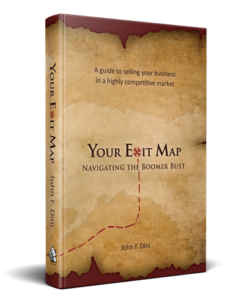In most businesses, employee retention is a material factor in valuation and transferability.
The ability of a buyer to assume control of a fully-functional organization has substantial influence on his or her perception of a company’s value. Any need to pay the seller for an extended period of training adds a redundant executive salary to the projected operating costs. Concern that key personnel may resign or be recruited away by a competitor adds a level of uncertainty to the transfer.
Of course, the basic premise of “The more you work in the business, the less it is worth.” always applies. Even if you’ve effectively delegated most of your operational responsibilities, however, there remains the threat of an exodus of corporate knowledge.
Many exiting owners don’t believe that the problem is theirs. “These people work for me because I treat them well.” they say. “A new owner should have no problem if he or she does the same.”
True enough, but every buyer’s confidence level is greatly increased by a mechanism to support employee retention through the transfer process.
Stay Bonuses
 Stay bonuses are so named (quite logically) because their purpose is to get key employees to stick around after a transfer of leadership. They can take a number of forms, but one of the most common is to escrow a portion of the sale proceeds for later payment if certain conditions are met.
Stay bonuses are so named (quite logically) because their purpose is to get key employees to stick around after a transfer of leadership. They can take a number of forms, but one of the most common is to escrow a portion of the sale proceeds for later payment if certain conditions are met.
The amount of the bonus can vary, but a general rule of thumb is about six months’ salary for two years of continued employment. Depending on the deal and the number of employees involved, this could be substantial. We suggest allocating about 5% of the sale price when planning such bonuses, but it could vary widely. Here are a few examples.
You sell your company for $5,000,000. Your four top executives each earn $200,000 a year. Six months of their salaries would be $200,000, or 4% of the sale.
On the other hand, if you have seven top executives at that level, $350,000 is 7% of your sale proceeds. That might be too rich a commission for your taste. The 5% guideline would make their bonuses about $35,000 or about 18% of salary.
Only you can decide whether the amount is motivational. Differing amounts based on position are normal. There is no requirement (such as in ERISA) that you apportion the funds by longevity or salary level.
Conditions of Payment
If you choose to make the bonus available, it only enhances the buyer’s confidence. Because the bonus is the seller’s liability, the new employer has no added financial motivation to keep or terminate any particular individual.
Bonuses are customarily forfeited upon resignation or termination for cause. Unlike other non-qualified deferred compensation plans, bonuses are typically not paid out in the event of the employee’s death or disability. This isn’t synthetic equity or a reward for general tenure. Qualification for payment is dependent on a specific condition being met at a specific time.
Also, unlike most NQDC plans, there is no buildup or gradual vesting of value. An employee who stays for 18 months isn’t eligible for three-quarters of a bonus. That should make stay bonuses free of claims in the event of an employee’s bankruptcy or divorce.
Employee Retention Alternatives
Employee retention is an issue in the transfer of any business with skilled personnel. Only you can determine whether it is worth the investment of offering stay bonuses.
If you are confident in employees’ loyalty to the company, one alternative is to place some of the sale price into an escrow account, to be released if turnover remains below a certain percentage for a specific time. This still allows you to retain the entire proceeds, but transfers some of the financial risk of turnover (even for non employment-related causes) to you.
The other approach is to rely on inertia and security to maintain your workforce in place. Those are strong motivations, and are sufficient in most cases.
Regardless of a buyer’s demands, remember that no one gave you financial guarantees of loyalty. You earned it, and it isn’t unreasonable to expect a buyer to do the same.

 For many owners, their biggest concern in an exit plan is maintaining control. Whether they seek to sell to employees, family or a third-party, there is a fear that, once started, the process will have its own rules and momentum.
For many owners, their biggest concern in an exit plan is maintaining control. Whether they seek to sell to employees, family or a third-party, there is a fear that, once started, the process will have its own rules and momentum.
 Your Exit Map, Navigating the Boomer Bust is now available on
Your Exit Map, Navigating the Boomer Bust is now available on